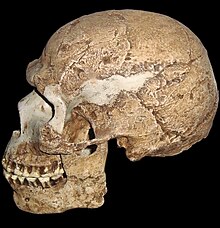
Back Vroeë moderne mens Afrikaans Homo sapiens sapiens Spanish انسان مدرن اولیه Persian Эртний орчин үеийн хүн Mongolian Vroege moderne mens Dutch ابتدايي نننی (معاصر) انسان Pashto/Pushto Humano anatomicamente moderno Portuguese Рани савремени човјек Serbian Người hiện đại sơ khai Vietnamese 早期现代人 Chinese

Early modern human (EMH), or anatomically modern human (AMH),[1] are terms used to distinguish Homo sapiens (the only extant Hominina species) that are anatomically consistent with the range of phenotypes seen in contemporary humans, from extinct archaic human species. This distinction is useful especially for times and regions where anatomically modern and archaic humans co-existed, for example, in Paleolithic Europe. Among the oldest known remains of Homo sapiens are those found at the Omo-Kibish I archaeological site in south-western Ethiopia, dating to about 233,000[2] to 196,000 years ago,[3] the Florisbad site in South Africa, dating to about 259,000 years ago, and the Jebel Irhoud site in Morocco, dated about 315,000 years ago.
Extinct species of the genus Homo include Homo erectus (extant from roughly 2 to 0.1 million years ago) and a number of other species (by some authors considered subspecies of either H. sapiens or H. erectus). The divergence of the lineage leading to H. sapiens out of ancestral H. erectus (or an intermediate species such as Homo antecessor) is estimated to have occurred in Africa roughly 500,000 years ago. The earliest fossil evidence of early modern humans appears in Africa around 300,000 years ago, with the earliest genetic splits among modern people, according to some evidence, dating to around the same time.[4][5][note 1][8] Sustained archaic human admixture with modern humans is known to have taken place both in Africa and (following the recent Out-Of-Africa expansion) in Eurasia, between about 100,000 and 30,000 years ago.[9]
- ^ Nitecki, Matthew H; Nitecki, Doris V (1994). Origins of Anatomically Modern Humans. Springer. ISBN 1489915079.
- ^ Vidal, Celine M.; Lane, Christine S.; Asfawrossen, Asrat; et al. (Jan 2022). "Age of the oldest known Homo sapiens from eastern Africa". Nature. 601 (7894): 579–583. Bibcode:2022Natur.601..579V. doi:10.1038/s41586-021-04275-8. PMC 8791829. PMID 35022610.
- ^ Hammond, Ashley S.; Royer, Danielle F.; Fleagle, John G. (Jul 2017). "The Omo-Kibish I pelvis". Journal of Human Evolution. 108: 199–219. doi:10.1016/j.jhevol.2017.04.004. ISSN 1095-8606. PMID 28552208.
- ^ Mounier, Aurélien; Lahr, Marta (2019). "Deciphering African late middle Pleistocene hominin diversity and the origin of our species". Nature Communications. 10 (1): 3406. Bibcode:2019NatCo..10.3406M. doi:10.1038/s41467-019-11213-w. PMC 6736881. PMID 31506422.
- ^ Scerri, Eleanor M. L.; Thomas, Mark G.; Manica, Andrea; Gunz, Philipp; Stock, Jay T.; Stringer, Chris; Grove, Matt; Groucutt, Huw S.; Timmermann, Axel; Rightmire, G. Philip; d'Errico, Francesco (2018-08-01). "Did Our Species Evolve in Subdivided Populations across Africa, and Why Does It Matter?". Trends in Ecology & Evolution. 33 (8): 582–594. doi:10.1016/j.tree.2018.05.005. ISSN 0169-5347. PMC 6092560. PMID 30007846.
- ^ Schlebusch; et al. (3 November 2017). "Southern African ancient genomes estimate modern human divergence to 350,000 to 260,000 years ago". Science. 358 (6363): 652–655. Bibcode:2017Sci...358..652S. doi:10.1126/science.aao6266. PMID 28971970.
- ^ Stringer, C (2012). "What makes a modern human". Nature. 485 (7396): 33–35. Bibcode:2012Natur.485...33S. doi:10.1038/485033a. PMID 22552077. S2CID 4420496.
- ^ Neubauer, Simon; Hublin, Jean-Jacques; Gunz, Philipp (2018-01-01). "The evolution of modern human brain shape". Science Advances. 4 (1): eaao5961. Bibcode:2018SciA....4.5961N. doi:10.1126/sciadv.aao5961. ISSN 2375-2548. PMC 5783678. PMID 29376123.
- ^ Harrod, James. "Harrod (2014) Suppl File Table 1 mtDNA language myth Database rev May 17 2019.doc". Mother Tongue.
Cite error: There are <ref group=note> tags on this page, but the references will not show without a {{reflist|group=note}} template (see the help page).
© MMXXIII Rich X Search. We shall prevail. All rights reserved. Rich X Search